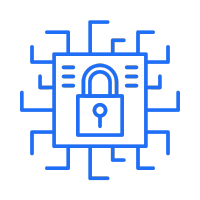The Authentication Gap in Self-Encrypting Drives
When you work in environments where classified or sensitive information is at stake, especially in the Department of Defense (DoD), security cannot be treated as a box to check. It has to be intentional, layered, and resilient. Hardware-based encryption through self-encrypting drives (SEDs) deliver encryption that creates an essential foundation for data security. But here is the reality: without the right authentication in front of that encryption, you are not really protecting anything. A drive that decrypts itself the moment you turn it on is no different than a regular hard drive, just one with a higher price tag.
This article takes a closer look at why pairing pre-boot authentication (PBA) with SEDs is non-negotiable, why NSA’s Commercial Solutions for Classified (CSfC) program is so important, and how the outer layer of the CSfC architecture is your only defense against attackers who thrive on OS-level vulnerabilities.
SEDs Are Strong, but They’re Not Enough
Self-encrypting drives are popular for a reason. They handle encryption in hardware, which means all data is automatically encrypted as it is written and decrypted as it is read, with no lag and no noticeable performance hit. Compared to software-only encryption, SEDs are faster and less vulnerable to traditional software-based attacks.
But here is the catch: encryption only works if you control who has the key. A system that powers on and decrypts itself automatically is basically handing the keys to whoever can press the power button. If an adversary gets physical access to your laptop, server, or storage array, and you don’t have pre-boot authentication in place, that encryption might as well not exist.
That’s the gap PBA closes.
Pre-Boot Authentication: The First and Best Gatekeeper
Think of PBA as a locked door between your data and your user. Without the right credentials, whether that’s a password, a smart card, a hardware token, or a combination of factors, the drive won’t decrypt and the OS won’t load.
This is critical in high-security environments because physical access isn’t a remote possibility; it’s inevitable. Devices are deployed in the field, sent across the globe, and are often in places where you can’t fully control who might get their hands on them. PBA ensures that even if an attacker walks away with your hardware, they do not walk away with your data.
Pairing PBA with SEDs offers:
- Hardware-grade encryption: Protection against complex attacks and advanced decryption attempts.
- Full Drive Locking: Every piece of data besides the PBA software is fully locked and unreadable even by the most advanced data recovery options.
- Authentication before the OS: Eliminates the risk of exploiting third-party software or operating system (OS) vulnerabilities to bypass security.
- Compliance with NSA standards: Meets and exceeds requirements for classified and sensitive data handling.
A drive with no PBA is like leaving the key in a lock. Add PBA, and that key stays with the people who are supposed to have it.
Why CSfC Certification Matters
Encryption technology is only as trustworthy as the process used to validate it. That is where the NSA’s Commercial Solutions for Classified (CSfC) program comes in. CSfC ensures that commercial products are tested, reviewed, and approved for use in classified environments. Additionally, it ensures no known vulnerabilities exist in the tested product, meeting the NSA standards.
Products and solutions that earn CSfC validation undergo rigorous evaluation in NSA-accredited laboratories. This gives government agencies and contractors confidence that their security solutions don’t just “work” but have mitigated all known vulnerabilities that adversaries can exploit.
For anyone working with sensitive or classified data, CSfC certification is not a nice-to-have; it is mandatory. It also represents a clear message: your security posture is not based on assumptions or marketing claims; it is built on a vetted, trusted foundation.
The Outer Layer: Where Security Really Begins
The CSfC model is all about defense in depth. Multiple encryption and authentication layers mean that if one fails, others remain in place to keep your data safe. Of all those layers, the outer layer is the most important because it is your first line of defense, and it kicks in before your operating system even loads.
Why is that a big deal? Because attackers can’t exploit software vulnerabilities or OS flaws if they never get past the pre-boot phase. With the outer layer implemented, access control is already in play, and the drive is fully locked down. By the time your OS starts, you have already defeated an entire category of attacks.
Real-World Impact for the DoD and Everyone Else
The DoD operates in some of the most challenging security environments imaginable. Devices are lost, stolen, or intercepted all the time. A misplaced laptop or external drive isn’t a hypothetical; it is a daily risk.
That is why relying on SEDs alone is dangerous. Yes, they encrypt data, but without PBA, that encryption is a hollow promise. Pairing PBA with SEDs and selecting CSfC-certified solutions creates a security posture strong enough to withstand today’s threats.
And this is not just a DoD problem. Critical infrastructure providers, financial institutions, and enterprises face the same risks. Hardware encryption, pre-boot authentication, and certified solutions together represent the gold standard for protecting sensitive data, no matter where it lives.
Bottom Line: Start Security Before the OS
Cybersecurity threats are constantly evolving, and attackers are always looking for the next weak point. If your only protection doesn’t start until after or while your OS loads, you have already given them a head start.
Combining self-encrypting drives with pre-boot authentication ensures your security perimeter is active the moment a system powers on. By choosing CSfC-certified solutions, you are not just encrypting data; you are investing in a security framework that has been tested, trusted, and approved for the most demanding environments.
If your mission depends on sensitive data, you cannot afford to compromise. Security has to start before the OS ever gets the chance to boot.
Ready to strengthen your data security with CSfC-certified solutions?
Don't leave your sensitive data vulnerable to physical access threats. Cigent's pre-boot authentication and self-encrypting drive solutions deliver the defense-in-depth protection your organization needs to meet NSA standards and safeguard classified information.
Schedule a consultation with our security experts to learn how we can help you implement a robust security framework that starts before the OS boots.








